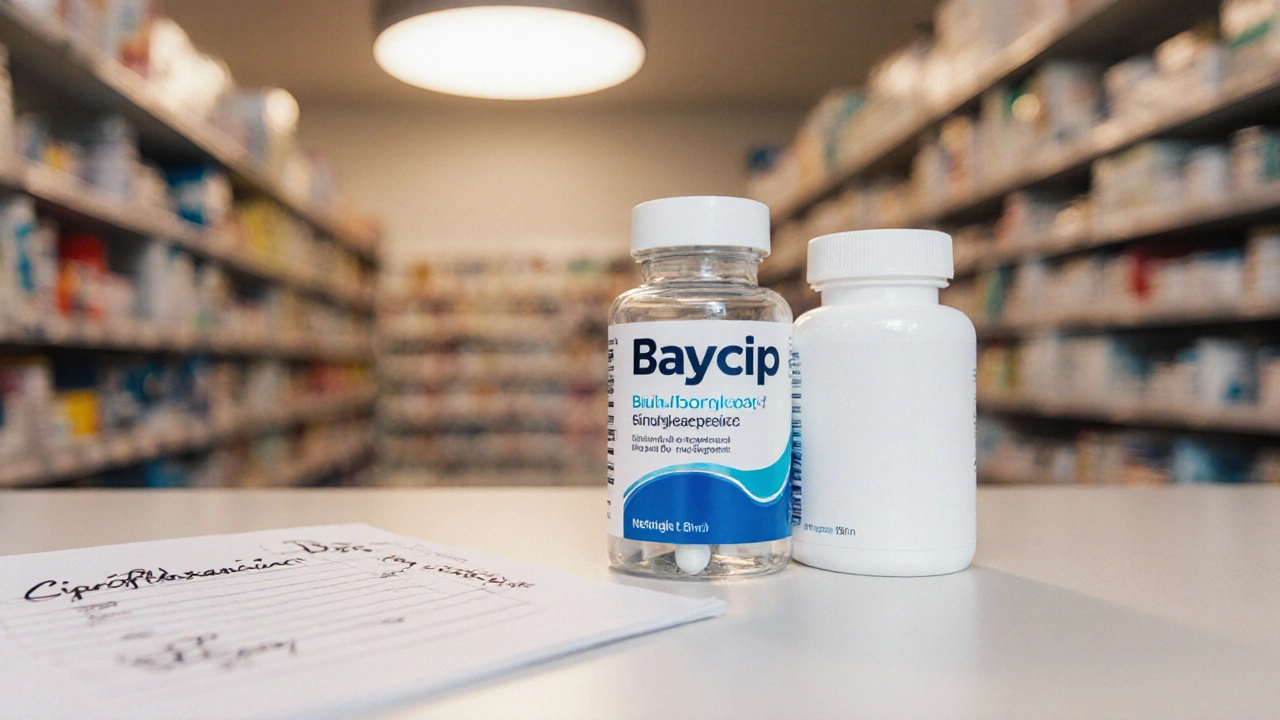Antibiotic Selection Tool
Identify Your Situation
Answer these questions to get personalized antibiotic recommendations based on your infection and health factors.
Key Takeaways
- Baycip is a brand‑name ciprofloxacin tablet used for a range of bacterial infections.
- Common alternatives include generic ciprofloxacin, levofloxacin, norfloxacin, amoxicillin and azithromycin.
- Effectiveness, side‑effect profile, dosing frequency and cost differ enough to affect the best choice for a given infection.
- Australian PBS subsidies can make some alternatives cheaper than Baycip.
- Safety considerations - especially tendon risk, QT‑prolongation and drug interactions - should guide the final decision.
What is Baycip (Ciprofloxacin)?
Baycip is a brand‑name formulation of ciprofloxacin, a fluoroquinolone antibiotic that works by inhibiting bacterial DNA gyrase and topoisomerase IV. In Australia it’s approved for urinary‑tract infections, certain respiratory infections, skin and soft‑tissue infections, and for prophylaxis after some surgeries.
Typical adult dosing is 500mg every 12hours for 7‑14days, but the exact schedule depends on the infection site and severity. Because it’s a fluoroquinolone, Baycip offers broad coverage against Gram‑negative organisms such as E. coli and Pseudomonas aeruginosa, plus some Gram‑positive bugs.
Common Alternatives to Baycip
When doctors look for an alternative they usually stay within the same therapeutic class or switch to a different class that covers the same pathogens. Below are the most frequently considered options in Australian practice.
- Generic ciprofloxacin - identical active ingredient, often cheaper.
- Levofloxacin - another fluoroquinolone with a slightly broader Gram‑positive spectrum.
- Norfloxacin - older fluoroquinolone, mainly used for uncomplicated urinary‑tract infections.
- Amoxicillin - a beta‑lactam antibiotic, excellent for many respiratory infections but not active against Pseudomonas.
- Azithromycin - a macrolide, useful for atypical pathogens and some sexually transmitted infections.
Side‑Effect Profiles at a Glance
All antibiotics have risks, but the fluoroquinolones, including Baycip, carry a few that deserve attention.
- tendon rupture - especially in patients over 60 or those on steroids.
- QT‑interval prolongation - can be problematic with other cardiac drugs.
- Gastro‑intestinal upset, photosensitivity, and rare central‑nervous‑system effects.
Levofloxacin shares most of these risks, while norfloxacin tends to cause fewer CNS effects but still bears the tendon warning. Beta‑lactams like amoxicillin are generally safer for tendons but can trigger allergic reactions. Azithromycin’s main concern is cardiac QT‑prolongation, especially in patients with existing heart disease.
Cost and Availability in Australia
The Pharmaceutical Benefits Scheme (PBS) subsidises many antibiotics, making them affordable for most patients. However, Baycip, being a brand name, is often priced higher than its generic counterpart.
Australian PBS lists generic ciprofloxacin at around AU$10 for a standard 14‑day course, while Baycip can run between AU$25‑30. Levofloxacin and norfloxacin are typically in the AU$12‑18 range, depending on dosage form. Amoxicillin and azithromycin are among the cheapest, often under AU$8 per course.
Side‑by‑Side Comparison
| Attribute | Baycip (Ciprofloxacin) | Generic Ciprofloxacin | Levofloxacin | Norfloxacin | Amoxicillin | Azithromycin |
|---|---|---|---|---|---|---|
| Drug class | Fluoroquinolone | Fluoroquinolone | Fluoroquinolone | Fluoroquinolone | Beta‑lactam (penicillin) | Macrolide |
| Typical spectrum | Gram‑negative, some Gram‑positive, Pseudomonas | Same as Baycip | Broader Gram‑positive, similar Gram‑negative | Uncomplicated UTI pathogens | Gram‑positive, some Gram‑negative (H. influenzae) | Atypical respiratory, Chlamydia, Gonorrhea |
| Dosing frequency | 500mg BID | 500mg BID | 500‑750mg QD | 400mg BID | 500mg TID or 875mg BID | 500mg QD (5‑day course) |
| Common side effects | Tendon pain, GI upset, photosensitivity | Same as Baycip | Tendon pain, CNS dizziness | GI upset, mild CNS | Allergic rash, GI upset | GI upset, QT prolongation |
| PBS cost (AU$) | 25‑30 (brand) | ~10 (generic) | 12‑16 | 12‑14 | ~6‑8 | ~7‑9 |
| Pregnancy safety | Use only if clearly needed | Same as Baycip | Category C - caution | Category C - caution | Category B - generally safe | Category B - generally safe |
How to Choose the Right Antibiotic for Your Infection
Picking the best option isn’t just about price. Consider these three decision points:
- Pathogen coverage: If the lab says Pseudomonas, a fluoroquinolone like Baycip or levofloxacin is usually needed. For typical strep throat, amoxicillin works better and avoids fluoroquinolone‑related tendon risk.
- Patient risk factors: Over‑60s, people on steroids, or those with cardiac disease should steer clear of fluoroquinolones if a safer alternative is available.
- Convenience and adherence: Once‑daily dosing (levofloxacin, azithromycin) can improve completion rates, especially for busy patients.
When in doubt, ask the prescriber for a culture test. Targeted therapy often lets you use a narrower‑spectrum drug like amoxicillin, sparing you the broader‑spectrum side effects of Baycip.

Safety Tips and Drug‑Interaction Checks
Before starting any of these antibiotics, run a quick medication review:
- Avoid combining fluoroquinolones with antacids, iron, calcium, or zinc supplements within two hours - they chew up absorption.
- Check for concurrent use of warfarin, theophylline, or certain anti‑epileptics; fluoroquinolones can raise blood levels.
- For azithromycin, review the patient’s QT‑interval status, especially if they’re on drugs like sotalol or certain antidepressants.
If tendon pain appears during therapy, stop the antibiotic immediately and seek medical advice. This is a red flag that applies to Baycip, levofloxacin and norfloxacin alike.
Accessing Baycip and Its Alternatives in Australia
Most of these medications require a prescription from a qualified prescriber. Here’s a quick roadmap:
- Visit your GP or a telehealth service. Explain symptoms, any recent labs, and mention if you have a history of tendon issues or cardiac conditions.
- If Baycip is prescribed, ask whether a generic ciprofloxacin is acceptable under the PBS - it will save you money.
- For antibiotics not listed on the PBS (e.g., certain brand‑only fluoroquinolones), discuss whether a PBS‑listed alternative like levofloxacin or amoxicillin can work.
- Use a reputable online pharmacy that complies with the Australian Therapeutic Goods Administration (TGA). Look for the ‘Approved’ badge and a clear pharmacy licence number.
- Keep a copy of the prescription and confirm the medication’s expiry date before you start the course.
Remember: completing the full prescribed course, even if you feel better, reduces the chance of resistance and relapse.
Next Steps If You’re Unsure Which Option Fits You
Don’t guess. Use the following checklist:
- Identify the infection type (UTI, respiratory, skin).
- Check recent lab results or ask the doctor for a culture.
- List any existing conditions (age>60, steroid use, heart disease).
- Review your current meds for possible interactions.
- Ask the prescriber about PBS coverage and possible generic swaps.
Follow the list, and you’ll end up with a choice that balances effectiveness, safety and cost.
Frequently Asked Questions
Is Baycip the same as generic ciprofloxacin?
Pharmacologically, yes - they contain the same active ingredient. The difference is brand‑name packaging and price. In most cases the generic version works just as well and is cheaper under the PBS.
When should I avoid fluoroquinolones like Baycip?
Avoid them if you’re over 60, taking steroids, have a history of tendon problems, or have a known QT‑prolongation issue. In those scenarios, a beta‑lactam or macrolide is often safer.
Can I take Baycip with an antacid?
No. Antacids, calcium, iron or zinc supplements bind to ciprofloxacin and cut absorption by up to 60%. Space them at least two hours apart.
Is amoxicillin a good alternative for a urinary‑tract infection?
Usually not. Most uncomplicated UTIs are caused by E.coli, which amoxicillin doesn’t reliably kill. Ciprofloxacin or nitrofurantoin are preferred unless the lab shows a susceptible organism.
How long does a typical Baycip course last?
The standard duration is 7 to 14days, depending on infection severity and site. Always finish the entire prescription even if symptoms improve early.

Kevin Zac
October 12, 2025 AT 14:15Hey folks, just wanted to add a quick note on the pharmacodynamic profiling of ciprofloxacin versus its generics – the molecule’s affinity for DNA gyrase remains invariant across brand formulations, but the excipient matrix can modulate bioavailability, especially in patients with altered gastric pH. In practice, that translates to marginal differences in Cmax and AUC that rarely affect clinical outcomes, yet the cost differential is substantial enough to warrant a PBS‑centric discussion.
Stephanie Pineda
October 22, 2025 AT 14:15Honestly, the whole Baycip vs generic debate feels a bit like choosing between a tuxedo and a denim jacket – both will get you to the party, but the price tag and the vibe differ. The article nailed the key points, though I wish it threw in a splash of color with a few real‑world anecdotes about people juggling antacids and fluoroquinolones. At the end of the day, the safest route is the one that doesn’t break the bank or your tendon.
Anne Snyder
November 1, 2025 AT 14:15Great summary! If you’re on steroids or over the age threshold, definitely lean toward nitrofurantoin or amoxicillin when appropriate – it’s a small tweak that can save you from a painful tendon episode. Remember, adherence shines when dosing is simple, so the once‑daily levofloxacin or azithromycin can be a game‑changer for busy schedules.
Rebecca M
November 11, 2025 AT 14:15While the overview is generally comprehensive, there are numerous inaccuracies that merit correction. Firstly, the statement that "Baycip offers strong coverage for tough Gram‑negative bugs" neglects the fact that ciprofloxacin’s spectrum does not reliably cover Enterococcus spp., which are clinically significant in certain urinary isolates. Moreover, the claim that "generic ciprofloxacin works just as well" overlooks the bioequivalence nuances arising from differing dissolution profiles; a slower‑release matrix could theoretically reduce peak plasma concentrations, thereby affecting bacterial kill curves. Additionally, the article fails to mention that fluoroquinolones, including Baycip, have been associated with collagen degradation, leading to not only tendon rupture but also an increased risk of aortic aneurysm, a point that is absent from the safety discussion. The dosage recommendation of 500 mg BID is accurate for many indications, yet for complicated skin infections, a higher 750 mg dose is often advocated, which the text omits. The section on drug‑interaction fails to address the potentiation of CNS toxicity when combined with other GABA‑modulating agents. Furthermore, the utility of culture‑directed therapy, which dramatically narrows the antimicrobial spectrum, is underemphasized. Finally, the table’s cost column neglects the fact that PBS subsidies can vary regionally, and the presented prices may not reflect out‑of‑pocket expenses for patients without concession cards. In summary, the piece, while useful for lay readers, would benefit greatly from a more rigorous pharmacological appraisal and the inclusion of recent FDA safety communications regarding fluoroquinolones.
Bianca Fernández Rodríguez
November 21, 2025 AT 14:15Okay, but i think the author missed the point that generic cipro is 100% the same and any brand is just a marketing steal. also the cost diff is not a big deal if you consider the hidden fees on insurance. In my opinon you should just ignore all the tables and ask the doc.
Samson Tobias
December 1, 2025 AT 14:15I appreciate the balanced view presented here; it’s crucial to weigh both efficacy and safety, especially for vulnerable groups. If you’ve got any lingering doubts, a quick chat with your pharmacist can clarify whether a PBS‑listed generic will meet your therapeutic goals without the premium price tag.
Alan Larkin
December 11, 2025 AT 14:15Just a quick heads‑up from my own experience: I was prescribed Baycip for a pesky UTI, but after taking it with my nightly calcium supplement I noticed a marked drop in effectiveness. I switched to nitrofurantoin and spaced the meds by three hours – problem solved. Timing matters more than most people realize.